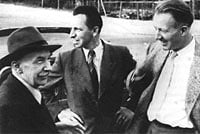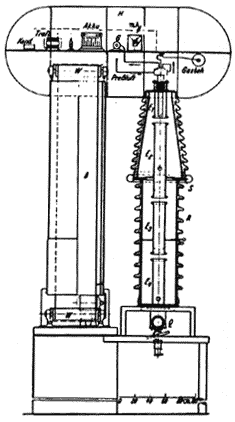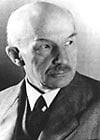The first third of the 20th century was a period of major revolutionary developments in physics. It began with Max Planck and Albert Einstein tearing down the reigning paradigm of Newtonian physics. Milestones in experimental work on the atom by the likes of Ernest Rutherford, Hans Geiger, and Arthur Compton soon followed. During the 1920s, Niels Bohr, Werner Heisenberg, Max Born, Wolfgang Pauli, James Franck and others laid the theoretical foundation of modern quantum mechanics. Such breakthroughs not only dramatically impacted on physics, but soon reverberated throughout other natural sciences, philosophy and international politics.
As a student and trusted assistant of Planck and Geiger, Walther Bothe was deeply immersed in this intellectual revolution.
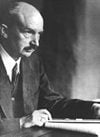
Walter Bothe
Photo: Courtesy of the Archiv zur Geschichte der Max-Planck-Gesselschaft, Berlin-Dahlem
When Bothe arrived at the KWImF in 1934, nuclear physics was still a novel field of inquiry, populated worldwide by a small esoteric group of scientists. Almost all experimental work in atomic physics had previously been done at the level of the electron shell. Knowledge of the central core of the atom was limited. Physicists were able to determine charges and nuclear weight; they knew about the proton and had just discovered the neutron; and they had some indication of the size of nuclei. But they had only begun to experiment with nuclear reactions. In short, how the nucleus was put together and functioned was still open to speculation.
The KWImF quickly became one of the foremost centers in the world for experimental nuclear physics. One of Bothe’s approaches was to gain insight into the nucleus by altering it or breaking it down into its various components. Indeed, Bothe’s experiments in 1930 had inspired James Chadwick‘s discovery of the neutron. Bothe’s group was also at the avant-garde of research groups creating radioactive isotopes and transmutations that resulted in minor elemental changes. Their foremost goal, however, was to determine the quantum mechanical energy relationships within the nuclei of a wide range of elements. After all, according to the newest theories of the time, energy and matter were essentially different perspectives on the same phenomena. If Bothe and his assistants could sort out the energy relationships within the nucleus, they would know what it is.
As a starting point, Bothe drew upon the then current understanding of the atom’s electron shell. Theory and experimentation indicated that electrons orbit the nucleus at discrete energy levels or shells. With the input of energy, electrons could be excited to “jump” to new levels. Early evidence indicated that the nucleus could also be excited to discrete energy levels. This indicated that nuclear structure was analogous to the electron shell. But this was yet to be proven. One goal at the KWImF was to bombard various elements with alpha-particles to induce such jumps to discrete energy levels in their nuclei and then measure the amount of energy of the products of the nuclear reactions.
Bothe’s group was one of the first to go beyond nuclear studies of light atoms and begin to explore the more difficult and complex reactions in elements of intermediate and heavy atomic weights. Inducing such reactions, however, required new technology to dramatically boost energy levels of the bombarding particles. Exploring this territory required accelerator technology that was just being developed and was extremely rare throughout the world. Bothe’s institute, for example, was the first in Germany to possess accelerators such as the Van de Graaff band generator and, later on, the cyclotron.
Bothe and his assistants pioneered techniques that would later become standard in nuclear physics. Bothe was world-renowned for his creation detection method, especially the coincidence method, and his group made dramatic improvements on these methods during the 1930s. At the time, Bothe’s was the only laboratory in the world using the coincidence method for nuclear research, giving them a distinct advantage in measuring and correlating a wide range of nuclear reactions. Such methods and equipment enabled KWImF scientists to pioneer research areas such as nuclear spectroscopy. Bothe and other scientists used these unique energy fingerprints to identify with certainty different elements involved in many reactions.
As we will see in following chapters, much of Bothe’s experimental momentum was slowed by the tragic events related to the Second World War. However, Bothe’s fundamental contributions to nuclear physics during the 1920s and 1930s were finally recognized in 1954, when he was awarded the Nobel Prize in Physics.
Bothe’s early career was shaped by the quantum revolution in physics
Born in 1891, Walther Bothe studied physics, mathematics, chemistry, and music at the University of Berlin, where he was quickly swept up in the excitement of the new physics. In 1912, he boldly approached Max Planck about doing doctoral research with the famous scientist. Planck asked Bothe what topic he had in mind and Bothe suggested a theoretical treatise on the refraction and reflection of light by single atoms. Planck took Bothe on, checking his progress twice in six months, the second time informing him that he should begin writing up his dissertation. Planck became Bothe’s mentor and lifelong friend. The trust and independence Planck granted Bothe permanently impressed the young man. He would later hold his own students at the KWImF to extremely high standards, yet never strayed from Planck’s notion that early research independence was the best route to scientific innovation.
By today’s standards, the international community of physicists during these years was extremely small and its members knew each other well. Bothe found himself placed at the very center of this movement, with all the advantages attached to being the protégé of one of its founders. Indeed, many of the most important figures during the development of modern physics were to weave their own stories through Bothe’s.
As Bothe was finishing his thesis with Planck, Hans Geiger was just returning from England in order to direct the new Laboratory for Radioactivity at Berlin’s Physikalische Technische Reichsanstalt (PTR). Geiger had spent six formative years working with Ernest Rutherford, who was a magnet for brilliant young scientists. In Manchester, Geiger first earned a reputation for the design of innovative radiation detectors. It was also there that he and Ernst Marsden did the experimental work that led Rutherford to propose the existence of the atomic nucleus. Just before Geiger left, a young Dane, Niels Bohr, also joined Rutherford. Bohr merged Rutherford’s idea of the nucleus with Planck’s and Einstein’s revolutionary theories of energy as particles (quanta or photons). This resulted in a new theoretical model that was pivotal in the history of physics – the electron shell model.
One of Geiger’s first steps upon returning to Germany was to hire Walther Bothe as an assistant. Geiger would become a second mentor to Bothe – the experimental twin of the great theoretician, Planck. It was Geiger’s example that influenced Bothe to maintain a relatively small number of highly qualified assistants at the KWImF, to select only the most urgent of all potential experiments and perform them with the simplest apparatus possible. In Geiger’s laboratory, Bothe was exposed to a steady stream of visiting scientists sent by Rutherford, as well as ongoing communication with scientists in Berlin like Einstein, Otto Hahn and Lise Meitner, and later Erwin Schrödinger.
Bothe’s career was put on temporary hold by the First World War. In May of 1914, he volunteered for the German cavalry, was taken prisoner and sent to Siberia for 5 years. Undaunted by his fate, he used this time in isolation to learn Russian, calculate his own set of logarithmic tables and work on theoretical problems concerning his doctoral work. When he returned to Berlin, he brought with him a Russian bride.
After six years, Bothe reunited with Geiger. In the interim, Geiger had refined his experimental techniques and equipment considerably. Bothe fused his strong theoretical ideas with Geiger’s experimental command, with the two forming one of the most productive experimental partnerships of the era. He and Geiger became the leading experts on small angle light scattering, with Bothe summarizing their findings in an influential handbook that established the foundation for modern methods of analysis of scattering processes.
Some of Geiger and Bothe’s most important contributions revolved around their development of the method of coincidence, which was used to detect atomic particles or radiation and associate them with individual atomic reactions or events. With the coincidence method, a number of individual counters could be arranged around a source that was to be bombarded. Finely tuned timers allowed them to detect whether the different detectors were activated simultaneously or in succession. Simultaneous detection provided evidence that different particles were by-products of a single atomic reaction, rather than two separate unrelated reactions. The coincidence method could also be used to measure the angle of deflection of particles in certain reactions – another important piece of information in regard to atomic reactions. Finally, coincidence counters could be lined up in succession or in parallel to determine the directionality of incoming particles or radiation from an unknown source. This would be important for Bothe’s subsequent studies of cosmic radiation.
In the early 1920s, Bothe was competing in the same research area as an American, named Arthur Compton. Several months before Compton made the same observations, Bothe detected the short track of recoil electrons induced by bombardment with X-rays. Compton won a Nobel Prize because his analysis went a step further and showed that the scattered quanta have less energy than the quanta of the original beam. The “Compton Effect” provided the first clear experimental support of the revolutionary predictions Einstein had made two decades earlier about the particle concept of electromagnetic radiation.
At the time, a controversial philosophical and scientific debate was also taking place between Einstein and Niels Bohr, the latter having proposed that atomic phenomena could only be considered in terms of statistical probability, rather than as concrete specific events. After Compton’s publication, Bothe and Geiger decided to use coincidence method to test the validity of the Compton Effect and compare it to the novel theories of Bohr and Slater. Their work provided critical proof for Einstein’s position by clearly demonstrating the principle of the conservation of energy in these interactions and that their detections were the result of specific causally related single-particle interactions with single electrons.
Bothe, who had assumed increasing responsibility at the PTR, took over the laboratory when Geiger left for a position at the University of Kiel. When the two colleagues sat down to divide laboratory projects, Geiger handed over the coincidence method to Bothe, a gesture that Bothe ever after considered an act of great generosity. Indeed, this assured Bothe’s professional reputation as he and students adapted and exploited the method in a wide variety of investigations over the next three decades.
In the late 1920s, for example, Bothe began using the method to study a peculiar kind of radiation that was particularly strong in the upper atmosphere. We now know this phenomenon as cosmic radiation. By taking coincidence measurements at various locations around the world, Bothe, W. Kolhörster and Italian collaborator Bernardo Rossi were able to define the incoming path of this radiation from deep space. In the process, they also detected the presence of penetrating charged particles in the radiation. Poorly understood at the time, their data prompted the then daring conclusion that this radiation was not primarily gamma rays, as was believed, but principally composed of the high energy material particles. These particles are today known as mesons. Cosmic radiation remained an area of investigation for Bothe for the rest of his life.
The most important applications of the coincidence method, however, would be made in the entirely new field of nuclear physics. In 1927, Bothe began to study the transformation of light weight elements by bombardment of the nucleus with alpha particles. With his refined counters, Bothe and collaborator H. Fränz were the first physicists to definitively correlate reaction products of specific interactions to levels of the nucleus.
In 1930, after moving to the University of Giessen, Bothe and assistant H. Becker made a startling and perplexing new discovery while investigating such reactions. They observed for the first time the emission of an entirely new form of high energy radiation that was even more penetrating than the hardest known gamma rays. Bothe decided that this was probably a new form of gamma radiation, although he was not entirely satisfied with his own analysis. Frédérick Joliot and Irène Curie, who worked in Paris and knew Bothe well, attempted to replicate and interpret the data. They too fell short of a satisfactory explanation of the phenomenon. Bothe and Becker’s experiments did, however, inspire James Chadwick to unearth an old theory of his former teacher, Rutherford. Chadwick won a well deserved Nobel Prize for his “discovery” of the neutron. Although Bothe’s contribution was widely recognized at the time, he once again narrowly missed earning science’s most prestigious award. A great interest in artificial radioactivity followed, especially in physics, but also later for the development of useful radioactive isotopes for chemical and medical research.
Bothe battles with Philipp Lenard at the University of Heidelberg
In 1932, Walther Bothe was called on to replace Philipp Lenard, the retiring director of the Institute of Physics at the University of Heidelberg. Lenard was a Nobel Prize winning physicist who had laid the experimental groundwork for Einstein’s famous photon theory of light. During the intervening years, Lenard had grown increasingly embittered by the ascendancy of Einstein, believing that Einstein’s fame had come at his own expense. Lenard disdainfully rejected the new theories that challenged Newton, especially Einstein’s theory of relativity and Bohr and Heisenberg’s quantum mechanics. His Physics Institute remained stubbornly entrenched in classical physics.
Lenard, who was a domineering and aggressive figure, still wielded great influence at the University. Lenard and another powerful faculty member and Nobel Prize winner, Johannes Stark, sharply criticized Bothe’s acceptance of the new theories and openly interfered with his administration. For his part, Bothe showed little patience for what he considered the anachronistic ideas of Lenard and Stark and was disgusted by behind-the-back attempts to undermine his authority. Unfortunately, Bothe lacked the kind of personality that would allow him to assertively fight the political battles necessary to counter such adversaries.
After Hitler’s rise to power in 1933, the situation took a dramatic turn for the worse. For over a decade, Lenard had expressed strong anti-Semitism and ardent support for the National Socialist movement in Germany. In fact, he was soon to become the recognized national leader of “Aryan Physics” under the Third Reich, with Stark as his right hand man. In the spring of 1933, the new government designated the country’s university system as a testing ground for inculcating its dogma. Among other things, they strongly frowned upon the theory of relativity and quantum mechanics, which they associated with Jewish scientists, presumed radicals and sympathizers. Throughout the country, they purged universities of Jewish academics and anyone else who dared to challenge the new decrees. Nowhere was this policy more in evidence than at the University of Heidelberg, which quickly became a hotbed of National Socialist ideology.
Bothe soon found himself forced out of his position as director of the University’s Physics Institute. Unfortunately, 1934 was not a good year to be an unemployed professor. Bothe was not the only academic in Germany with such problems. With the Nazis firmly in control of the universities, it was almost impossible to find a similar position at another university, while opportunities at private institutes or industry were also limited. Many of the country’s scientists suddenly found themselves looking for work abroad. Bothe was considered by many to be a prime candidate for emigration.
“Geiger was offered the chair in Physics at the University of Heidelberg at the retirement of Philipp Lenard, but Lenard found some reason to reject him. Then they gave it to Bothe – not that it helped him, because Lenard began to attack Bothe as soon as he arrived. In any event, after Bothe was forced out, the University again asked Geiger if he wanted the job. Geiger decided to come to Heidelberg to speak to Lenard and invited me to come along. When we climbed the hill to Lenard’s institute and knocked on the door, the Hausmeister went upstairs to announce our arrival. He came back a few minutes later and said ‘Geheimrat Lenard has no interest in seeing you, Herr Geiger’.
Geiger walked away, gave a little laugh and told me he never imagined such an arrogant greeting. Then, as if to say it did not matter, he told me that he would take me to visit a really nice institute. I was used to much more modest facilities than Lenard’s institute, so I was dubious. But I was very pleasantly surprised when I reached the KWI on the banks of the Neckar. The facilities proved to be outstanding. But what I remember most was the greeting Bothe and Geiger gave each other. You have to know that Geiger was a very unemotional sort and, as I learned later, Bothe could sometimes seem cold and remote. But the two immediately embraced each other. Bothe asked how it went. Geiger shook his head and replied simply ‘Thrown out!’ And then the two stood there laughing so hard with their arms on each other’s shoulders. I never saw such emotion from Geiger again. He and Bothe were obviously fast friends.”
Sadly, Haxel died only days after this interview.
Otto Haxel remembers Hans Geiger and Bothe
|
| Otto Haxel first met Walther Bothe in the 1930s while on a visit to Heidelberg with Hans Geiger. Pictured above are Bothe, Haxel and Hans Kopfermann. Bothe recruited the latter two to direct the Physics Institute at the University of Heidelberg. Photo: Courtesy of Max-Planck-Institut für Medizinische Forschung |
Bothe selected as Director of KWImF Nuclear Physics
Max Planck, who had replaced Adolf Harnack as President of the KWG in 1930, was painfully aware that the exodus of scientists represented a grave danger to German science. Moreover, he was personally concerned about losing the talents of one of his former students. Fortunately, the Kaiser Wilhelm Gesellschaft’s international prestige and legal status as a private organization enabled it to retain and hire scientists of its choice, as well as to pursue research free of government interference – at least during the early years of the Third Reich. Aware of the vacant directorship in physics at the KWImF, Planck approached Ludwig von Krehl about offering the position to Bothe. Krehl knew that Bothe’s research was a poor fit to his vision of combining basic sciences for medical research, but he also recognized the unusual circumstances under which Planck made the request and agreed to the emergency offer.
Bothe gladly accepted the new position, moving a kilometer down the north bank of the Neckar River to his new laboratory. Besides an escape from the politics of the University, the KWImF offered complete research independence and no teaching responsibilities. It was much better funded than the University’s Physics Institute, with a fine library, equipment and excellent workshops. Organizing his new Nuclear Physics Institute would be a challenge, but not an overwhelming task. In fact, it was a surprising step forward for Bothe.
On the other hand, given the research of Bothe’s fellow KWImF directors, his poor relations with the university, and the fact that he was far from the other great centers for German physics in Berlin, Leipzig and Göttingen, Bothe knew that he risked professional isolation. This heightened his need for highly qualified assistants and technicians who would be able to work independently. Bothe emphasized quality over quantity in his recruitment, providing positions for only three to five assistants. Rudolf Fleischmann, who had worked with Bothe briefly at the University of Heidelberg, had been a student of Robert Pohl, one of the most respected physicists in Göttingen. He brought experience in the development of scintillation counters, research on the photo-effect involving electrons and studies of absorption spectra. Fleischmann encouraged Bothe to recruit another promising young physicist, named Wolfgang Gentner. At the time, Gentner was working at Madame Curie‘s Institute in Paris on the photo-effect on nuclei of light elements. Soon after Gentner arrived in Heidelberg, Bothe also recruited Heinz Maier-Leibnitz, who had done his doctorate with the Nobel Laureate James Franck.
Nuclear physics at the KWImF during the 1930s
Bothe and his assistants began bombarding nuclei with different types of particles and radiation, examining the types of reactions taking place under specific experimental circumstances.
The most important of these assistants was Wolfgang Gentner. At the University of Frankfurt, Gentner had studied medicine and biology before finally settling on a career in physics. In 1932, he had moved to Paris and became the first German postdoctoral fellow to work at Madame Curie’s Radium Institute at the Sorbonne since 1912. The experience in Paris was a pivotal one in Gentner’s life. There he gained a deep admiration for French culture and the cosmopolitan attitude that typified his temperament. He also made acquaintance with many leading French physicists, forming a long lasting friendship with Frederick Joliot. These experiences proved to have a critical impact on the history of German and French physics.
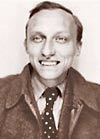 |
Wolfgang Gentner in the early 1930s. Photo: Courtesy of the Archiv zur Geschichte der Max-Planck-Gesselschaft, Berlin-Dahlem |
Gentner’s work on the effects of gamma radiation on various elements, especially measurements of the active cross-section of the nuclear photo-effect on Beryllium, had impressed Bothe. He invited Gentner to continue his studies at the KWImF. Attracted by the opportunity to return to his homeland and work with Bothe, Gentner accepted. His return to Germany in 1935 was not without ambivalence, for he was markedly disillusioned by the political and social changes under the National Socialists during his absence. The development of a warm relationship with Bothe, however, softened this blow.
Bothe and Gentner both understood that the radiation sources Gentner had used in Paris did not produce bombardment gamma-rays at sufficient energy to efficiently affect neutrons in heavier nuclei. It was clear they would have to raise the energy level if they were to make progress measuring the photo-effect in more complex nuclei.
Eight years earlier, the American physicist Van de Graaff had built a band generator – an early electrostatic linear accelerator, capable of boosting the intensity of bombardment particles compared to radioactive sources. Bothe asked Gentner to build such a generator at the KWImF. With the aid of the KWImF workshops, Gentner made amazingly quick progress. Within nine months, the newly constructed band generator was used to boost the energy to the 500 thousand electron volts (KeV) level, enabling Gentner to generate gamma-rays of 17 million electron volts (MeV) by bombarding 7Li with protons. These gamma-rays made possible the first recording of the nuclear photo-effect upon intermediate weight elements. By April 1937, Gentner had determined the photo-effect for more than a dozen nuclei.
Gentner’s and Bothe’s publication in 1938 of the energy dependence of the nuclear photo-effect represented the first decisive evidence that absorption spectra of nuclei are accumulative and continuous. This was the first evidence of an extremely important phenomenon that would later become known as dipolar giant nuclear resonance. This resonance was explained theoretically a decade later by Jensen, as well as Goldhaber and Teller.
By April 1938, Gentner had determined the wavelength dependence of the photo-effect for more than a dozen radioactive nuclei. He painstakingly ascertained under which circumstances specific forms of energy or particles were emitted from or absorbed by the nuclei, as well as what rules applied for the creation of specific changes in the nucleus. Gentner and Bothe’s publication in 1938 of the energy wavelength dependence of the nuclear photo-effect represented the first decisive evidence that absorption spectra of nuclei are accumulative and continuous. This was the first evidence of a an extremely important phenomenon that would later become known as dipolar giant nuclear resonance (the full discovery was made independently a decade later by Jensen, Teller and Goldhaber).
The mechanical and electrical worskshops at the KWImF were critical to the scientific successes there. Most experimental equipment was built in-house until the 1960s. In the 1930s, this included tube amplifier to apparatuses that occupied several stories of building space. KWImF’s scientists, engineers and technicians were particularly adept at advancing detector technology. The Van de Graaf band generator, pictured above, was built by Gothe and Wolfgang Gentner in 1936 and was used as a particle accelerator to investigate the nuclear photo-effect in middle weight elements. It was the first accelerator of its kind in Europe.
Almost all equipment at the KWImF was made in-house during the 1930s
|
| Kanalstrahlanlage Photo: Courtesy of Max-Planck-Institut für Medizinische Forschung |
Encouraged by these successes with the Van de Graaff band generator, Bothe made plans to build an even more powerful accelerator – a cyclotron – patterned after the invention of Sloan and Lawrence at the University of California. In 1938, Bothe furiously applied to the KWG, the German government and private foundations for funding and, toward the end of the year, ordered the 80 ton magnet for the cyclotron, then sent Gentner to Berkeley to learn as much as he could from Lawrence about the construction process.
Despite their difference in age and status, Gentner made a profound impression upon Bothe. His work on the nuclear photo-effect on middle-heavy and heavy elements represents the single most valuable contribution of the Institute during the prewar years. But Gentner’s erudition, creativity, willingness to share his knowledge, as well as his courage and humanity, greatly impressed his colleagues at the KWImF. He quickly became recognized as Bothe’s second in command and was revered by many of the younger scientists, including the newest assistant, Heinz Maier-Leibnitz.
Bothe had first met Maier-Leibnitz while on a recruiting trip to Göttingen. Despite being by his own description a novice in the field of nuclear physics, Maier-Leibnitz came highly recommended by both Robert Pohl and Georg Joos for his intelligence and creativity. The 26 year-old Maier-Leibnitz had joined the KWImF only a few months after Gentner’s arrival and he immediately took Maier-Leibnitz under his wing, becoming mentor, critic and a close friend.
As Maier-Leibnitz arrived, Bothe asked an advanced doctoral student, Hans von Baeyer, to hand over a project on coincidence measurements to Maier-Leibnitz. This was work that extended Bothe and Becker’s studies that had led to Chadwick’s discovery of the neutron. Baeyer generously helped Maier-Leibnitz come up to speed with the new coincidence apparatus. Bothe also worked closely with him during this introductory phase.
Bothe had not pulled Baeyer off the project because of lack of progress, nor because of Maier-Leibnitz’ seniority. Indeed, Baeyer’s measurements had already confirmed and augmented data that showed that excited nuclei pass through different states of energy when particles are emitted – evidence that pointed to similarities with Bohr’s theory of the electron shell excitation and emission. But Baeyer was Jewish. He had already been forced out of the University’s Physics Institute in 1934, coming to the KWImF at the invitation of Bothe. By early 1935, personal safety for “non-Aryans” was becoming increasingly precarious and Baeyer was forced to emigrate to Canada.
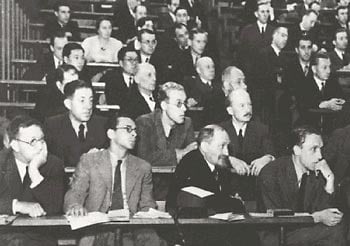 |
| A physics conference in Paris in 1937 during the discussion of Wolfgang Gentner’s lecture on the nuclear photo-effect. Front row: (left to right) Cockcroft, Goldhaber, Mauguin and Gentner. Second row: (left to right) Herzog, Maier-Leibnitz and Bothe. Seated along the aisle is Bohr, with Fleischmann just behind him. Photo: Courtesy of the Archiv zur Geschichte der Max-Planck-Gesselschaft, Berlin-Dahlem |
Maier-Leibnitz’ first assignment was to provide conclusive proofs of the association of the Compton Effect to the light quantum hypothesis. Using an apparatus designed by Bothe, Maier-Leibnitz worked on angle correlations between Compton-electron and scattered gamma quantum. By altering the location of a foil that was used to scatter their beam, they observed the scattering angle. Maier-Leibnitz increased the sensitivity of the coincidence measurements to within 1/600,000 of a second, thus greatly strengthening the reliability of the data.
Maier-Leibnitz was now able to convince Bothe that he was ready to design his own projects. He continued working with the coincidence apparatus and teamed with W. Mauer, who had built an ionization chamber at the department. Together they provided the first indication of an isomeric state in Carbon 13. In 1938, Maier-Leibnitz built his own Wilson cloud chamber, which remained sensitive for up to one to two seconds – a major improvement at the time. The cloud chamber was used to compile images for later publication of Bothe, Gentner and Maier-Leibnitz’ Atlas of Typical Cloud Chamber Images – a document that would become a standard reference for identifying different scattered particles.
Although Krehl did not live to witness it himself, the generation of radioactive isotopes at the KWImF during this period led to a scientific collaboration that embodied the potential of Krehl’s principle of bringing together biology, physics and chemistry together. Shortly after Meyerhof fled Germany in 1938, his assistant Paul Ohlmeyer worked with Gentner and Maier-Leibnitz to develop radioactive phosphorus isotopes that were used to trace intermediate reactions of glycolysis. As fate would have it, this ground breaking work went unrecognized outside of Germany for almost a decade.
W. Mauer, who had built the first ionization chamber used by Maier-Leibnitz, continued to use the chamber for his own studies of neutron emissions resulting from alpha bombardment of different isotopes of Boron and analysis of the related distribution of energy levels in the nucleus. Ernst Wilhelmy also built an ionization chamber for determination of spectra from nuclear reactions, principally focusing on the spectroscopic studies alpha emissions after neutron bombardment from nuclei of the Nitrogen isotope, 14N. The measurement of discharge resonance from these reactions was, at the time, the first confirmation of Bohr’s theory of compound nuclear reactions. Unfortunately, Wilhelmy’s promising career was cut short when he died in 1937, a tragic loss which Bothe took very hard.
Other important efforts during the 1930s involved continuation of Bothe’s investigations of cosmic radiation. K. Schmeiser, a student who would definitively earn his reputation at the Institute in the 1950s, worked on coincidence measurements of cosmic radiation showers, the Rossi curve, and Rossi Maxima.
During this time, Rudolf Fleischmann, Bothe’s senior assistant, had concentrated on his own research at the KWImF on nuclear reactions induced by neutrons. The discovery of the neutron at the beginning of the decade had represented a tremendous breakthrough for nuclear physics. As a heavy particle within the nucleus, it helped reconcile then perplexing differences between atomic weight and atomic number. The differences between various isotopes could then be understood as minor variations of the number of neutrons in a nucleus. Moreover, from a practical point of view, the neutron represented a tremendous new experimental tool. As a heavy particle with no charge, it could be used as a powerful projectile in bombardment experiments.
Enrico Fermi had recently learned that neutrons in a bombarding beam are dramatically slowed down when fired through paraffin. This slowing of the neutrons, as Fermi had discovered quite by accident, made them far more effective in causing reactions within the nucleus. Using Bothe’s coincidence geometry, Fleischmann made considerable advances determining causal relationships between neutron bombardment, energy absorption and emissions of gamma radiation spectra. He was the first to measure the middle level gamma radiation energy.
Throughout the thirties, Bothe was in direct, albeit friendly, competition with the laboratories of Fermi, Hahn and the Joliot-Curie. In 1938, believing that his own research with neutrons was falling behind these other groups, Bothe asked Fleischmann to switch projects and begin purifying isotopes. At the time, this was an extremely difficult and time consuming task, but because Wolfgang Gentner had recently obtained important results on high-energy gamma emission with an isotope of lithium, Bothe hoped to make similar progress with studies of isotopes of the heavier element, nitrogen. Fleischmann built a three story high glass tube separation device at the KWImF, called a Clusius apparatus. Although he quickly succeeded in separating the isotope of nitrogen, 15N, the initial test reactions of protons resulted not in high energy gamma rays.
Before this research could proceed any further, however, Bothe and his colleagues learned of the splitting of the atom in Berlin by Otto Hahn and Fritz Strassmann. In the spring of 1939, Bothe was called to Berlin to meet with a small group of German scientists, which became known as the Uranverein (the Uranium Club in English). War was clearly on the horizon and the Uranverein was charged with investigating military applications of the splitting of the atom, including the possibility of building an explosive device. Upon his return to Heidelberg, Bothe asked Fleischmann to try the purification of the isotope of Uranium, 235U.
The invasion of Poland in September of 1939 brought this chapter of Bothe’s institute to an end. Bothe and his assistants were literally drafted into the Uranverein to to investigate the use of atomic energy for military applications. Although they performed a surprising amount of pure research during this time, the turmoil of the war and its aftermath curtailed Bothe research in the field of nuclear physics for more than a decade. In the 1950s, the Institute made a full recovery. Bothe himself received the Nobel Prize in Physics in 1954. Seven years later, Rudolf Mössbauer received a Nobel “for his researches concerning the resonance absorption of gamma radiation and his discovery in this connection of the effect which bears his name while a student working at the MPImF. A year after Bothe’s death in 1957, Wolfgang Gentner returned to Heidelberg and took over Bothe’s research group, establishing an independent Max Planck Institute for Nuclear Physics.
Walther Bothe was both a strong theoretician and one of the most accomplished experimental physicists of the first half of the 20th century. He had an astonishing gift of concentration, which enabled him to work at great speed. He granted his assistants and students broad independence, but in return set high standards of dedication, discipline and creativity. He demanded nothing from others, however, that he did not expect of himself.
Bothe was a loner and often sensitive to criticism. He did not suffer fools gladly, but also disliked direct confrontation, often dealing out his strongest criticisms with a silent, brooding stare. If he felt an assistant’s project was moving too slowly, he might simply walk out on a progress report, only to return sternly the next day with a solution or a new piece of equipment that he had designed overnight. On the otherhand, on rare occasions that he was wrong or underestimated a student’s ideas, he admitted it – although this was usually done the next day in an equally curt manner.
For those who worked closely with him, Bothe’s integrity outweighed his thorny personality. He disdained dogma and crass political machinations. His difficulty in dealing diplomatically with conflict, however, often caused him problems. He had a series of run-ins with fellow KWImF director Richard Kuhn and his impatience with the Nazis, as well as the Gestapo’s suspicion of him, are well documented. Despite his disdain of the National Socialists, he considered himself a German patriot, and never offered excuses for contributing to German efforts to design an atomic bomb during the Second World War.
In his personal life, Bothe tended to keep his problems to himself. Once away from the laboratory, he was considered a family man and a kind friend. It was then that he was most able to relax and show his lighter side. He was passionate about art and music, an accomplished pianist, who found relaxation painting on his frequent trips to the mountains.
Walther Bothe was brilliant, disciplined, and notoriously thin-skinned
|
Walther Bothe Photo: Courtesy of the Archiv zur Geschichte der Max-Planck-Gesselschaft, Berlin-Dahlem |
